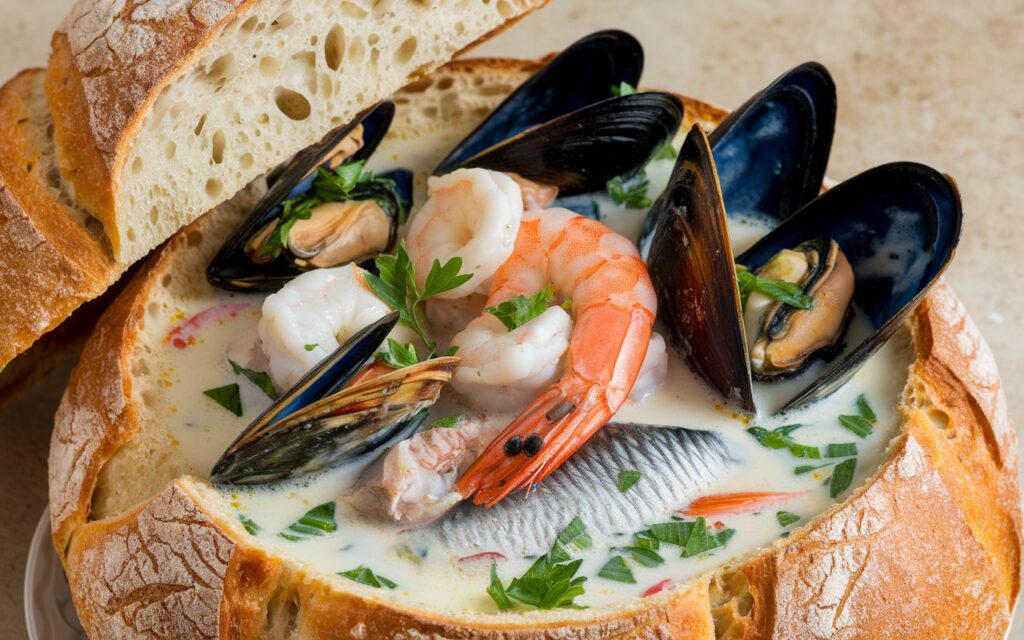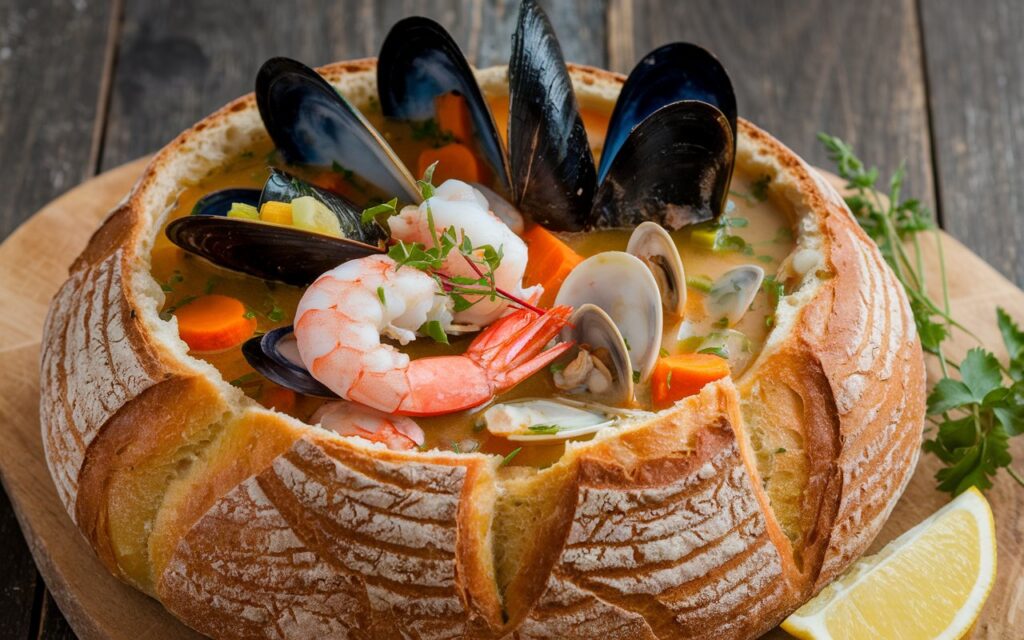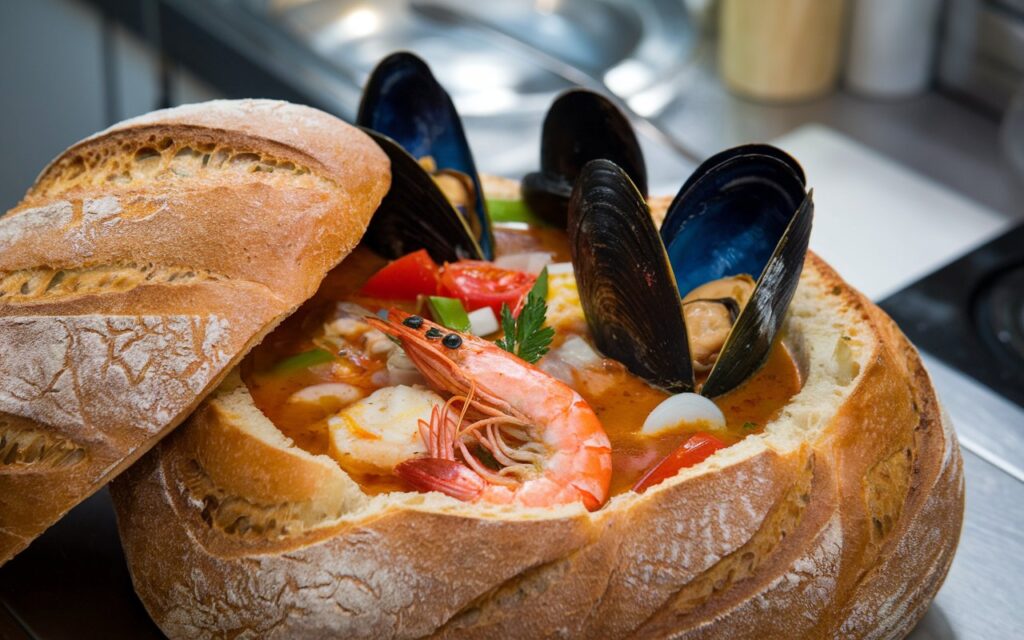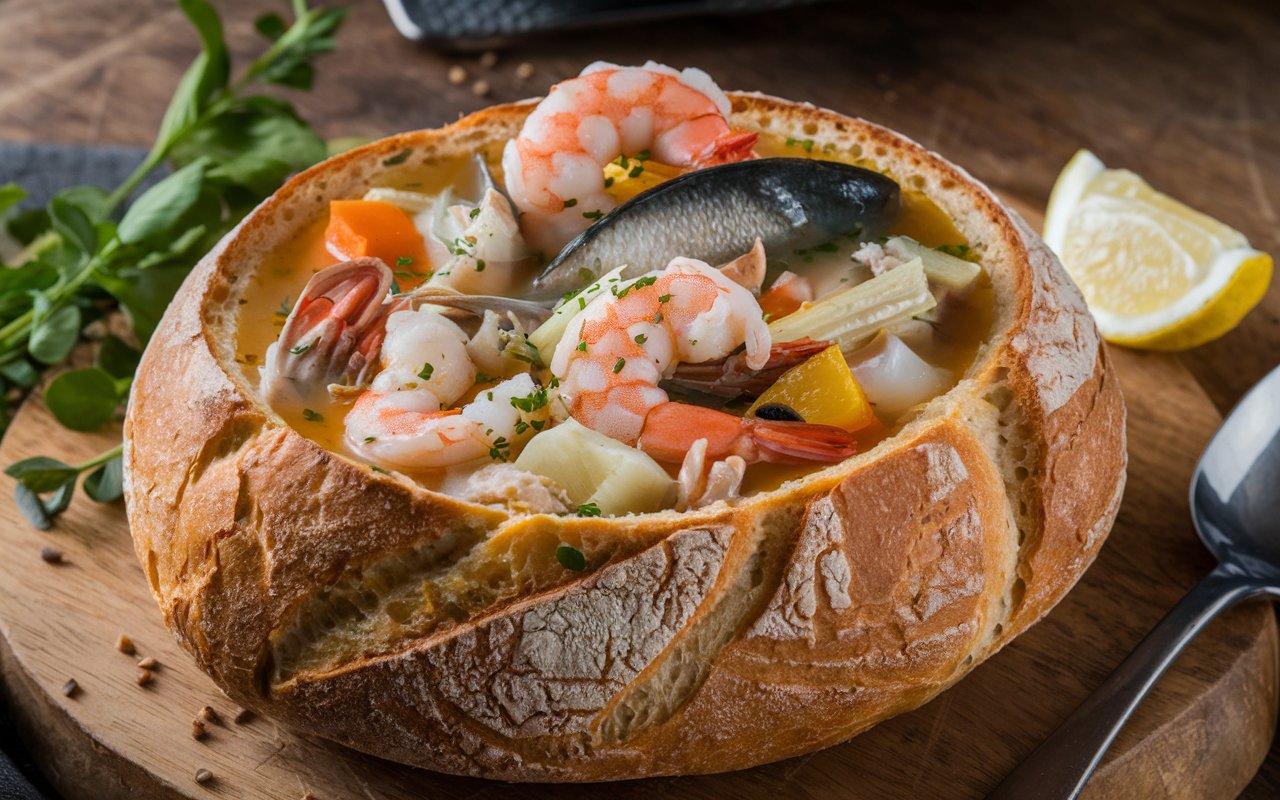Nothing beats the comfort of a warm, flavorful soup served in an edible bread bowl, especially when it features the exquisite flavors of the ocean. The Stuffed Seafood Soup Bread Bowl is a perfect union of creamy or savory soup packed with seafood delicacies, nestled in a rustic, hollowed-out loaf. This dish blends culinary creativity, sustainability, and gourmet indulgence, making it a favorite among food enthusiasts. Let’s dive into its origins, benefits, and why it has captured the hearts of foodies worldwide.
The Origin and Popularity of Bread Bowls

The bread bowl has a storied history that dates back to the Middle Ages, when bowls made from hollowed-out loaves of bread were used as economical and sustainable serving dishes. Over time, this concept evolved into a culinary trend that remains popular for its rustic charm and practicality.
Bread bowls gained traction in modern cuisine due to their unique combination of functionality and flavor. They eliminate the need for extra dishware and provide an interactive dining experience where the container becomes part of the meal. Whether at casual eateries or gourmet restaurants, bread bowls are a hit among diners seeking an innovative twist to traditional soups.
Why Seafood Soup is Perfect for a Bread Bowl
Combining Flavors of the Ocean with Rustic Bread
Seafood soups are renowned for their richness and diverse textures. When paired with a bread bowl, the combination creates a perfect harmony of flavors. The buttery, flaky seafood melds beautifully with the crusty yet tender bread, soaking up the soup’s essence and enhancing every bite.
The bread’s slightly tangy or sweet notes complement the salty and umami flavors of seafood, resulting in a dish that is both hearty and satisfying. This pairing is ideal for cold-weather comfort food or as a show-stopping centerpiece for special occasions.
Who Loves This Dish: A Favorite Among Food Enthusiasts
The Stuffed Seafood Soup Bread Bowl appeals to various audiences:
- Gourmands seeking luxurious dishes made with fresh ingredients.
- Eco-conscious diners who appreciate the sustainability of edible serving options.
- Home cooks and chefs aiming to impress guests with a visually striking and delicious presentation.
The dish caters to diverse tastes, offering versatility in ingredients and preparation methods.
Benefits of Serving Soup in a Bread Bowl
Eco-Friendly and Edible Serving Option
Bread bowls eliminate the need for disposable or reusable bowls, making them an eco-friendly choice. This edible option minimizes waste and adds an innovative touch to the dining experience. It’s a simple way to marry sustainability with indulgence.
Enhances the Dining Experience with Savory Layers
One of the most exciting aspects of a bread bowl is how it evolves as you eat:
- The crusty exterior remains firm, while the inside absorbs the soup, transforming into a savory, flavor-packed treat.
- Diners can tear pieces of the bowl to enjoy alongside the soup, creating an immersive experience that delights both the palate and senses.
Types of Seafood That Work Well in Soup
Choosing the right seafood is essential for creating a flavorful, well-balanced soup. Here are some popular options:
Shellfish (Shrimp, Crab, Lobster)
Shellfish add a delicate sweetness and tender texture to the soup. Shrimp, crab, and lobster are versatile ingredients that pair well with creamy or broth-based bases. They elevate the dish into a luxurious treat.
Fish (Cod, Salmon, Halibut)
Fish like cod, salmon, and halibut bring a light, flaky texture and mild flavor to the soup. They are perfect for creating a balanced profile, especially when combined with hearty vegetables and herbs.
Clams, Mussels, and Other Delicacies
Clams and mussels add a briny, oceanic depth to seafood soup. Their juices enrich the broth, intensifying the flavors while providing a unique texture that seafood lovers adore.
Essential Ingredients for Stuffed Seafood Soup Bread Bowl
Creating the perfect Stuffed Seafood Soup Bread Bowl begins with selecting high-quality ingredients. Each component, from the seafood to the bread bowl, plays a crucial role in delivering flavor and texture. This section explores the essentials for crafting a dish that’s both impressive and delicious.
The Seafood: Selecting Fresh, High-Quality Options

The success of this dish hinges on the freshness and quality of the seafood. Fresh seafood ensures vibrant flavors and avoids unwanted textures or odors.
Best Places to Source Fresh Seafood Locally or Online
- Local Fish Markets: Visit nearby fish markets for the freshest selection. Engage with vendors to learn about the catch of the day and sourcing practices.
- Online Seafood Retailers: Many reputable sites offer overnight shipping for premium seafood, ensuring quality and freshness.
- Supermarkets with a Fresh Counter: Many supermarkets feature a seafood counter with options sourced locally or sustainably.
Always check for clear eyes in fish, firm flesh, and a clean oceanic smell when buying fresh.
The Soup Base: Creamy or Broth-Based Options
The base of the soup determines its richness and overall flavor profile. Choose between a creamy or broth-based soup depending on your preference.
Using Stock, Cream, and Herbs for Flavor Depth
- Cream-Based Soup: Use heavy cream, milk, or half-and-half for a luxurious texture. Pair with butter and aromatic herbs like thyme for added complexity.
- Broth-Based Soup: Opt for seafood stock or chicken stock as a lighter alternative. Infuse the broth with garlic, onions, and bay leaves to enhance its depth.
- Herbs and Aromatics: Fresh dill, parsley, and paprika can elevate the flavor, adding brightness and warmth to the soup.
The base is where flavors build, so be sure to season generously and taste frequently as you cook.
Crafting the Perfect Bread Bowl
A great bread bowl combines sturdiness with a soft interior, capable of holding soup without becoming soggy.
Bread Types: Sourdough, French Loaf, or Rye
- Sourdough: Known for its tangy flavor and sturdy crust, sourdough is the most popular choice for bread bowls.
- French Loaf: Offers a crisp exterior and neutral flavor, letting the soup take center stage.
- Rye Bread: Adds a unique, earthy flavor that pairs well with rich, creamy seafood soups.
Hollowing Out and Preparing the Bowl for Soup
- Cut a circular lid from the top of the bread loaf.
- Use a spoon or your hands to hollow out the interior, leaving a sturdy wall to hold the soup.
- Brush the interior with melted butter or olive oil and lightly toast it to prevent sogginess.
Proper preparation ensures the bread bowl maintains its structure while soaking up the soup’s essence.
Additional Ingredients to Elevate Flavor
The right seasonings and additions can take your seafood soup to the next level.
Seasonings: Old Bay, Garlic, Thyme, and Paprika
- Old Bay Seasoning: A classic choice for seafood dishes, offering a blend of spices like celery salt and paprika.
- Garlic: Fresh or roasted garlic adds depth and an aromatic boost.
- Thyme and Paprika: Thyme adds a subtle earthiness, while paprika contributes a smoky, sweet undertone.
Optional Additions: Corn, Potatoes, and Vegetables
- Corn: Adds sweetness and a burst of texture.
- Potatoes: A creamy addition that thickens the soup and complements seafood flavors.
- Other Vegetables: Leeks, carrots, or celery enhance the broth with a savory base.
These ingredients create layers of flavor and texture, ensuring every bite is memorable.
FAQs About Stuffed Seafood Soup Bread Bowls
Here are the most frequently asked questions about Stuffed Seafood Soup Bread Bowls, providing additional tips and insights for creating and enjoying this delectable dish.
1. Can I make bread bowls in advance?
Yes, bread bowls can be prepared a day ahead. Hollow them out, brush the interior with butter or olive oil, and store them in an airtight container. Reheat in the oven at 350°F for 5–7 minutes before serving.
2. What’s the best way to thicken seafood soup?
You can thicken seafood soup by:
- Creating a roux with butter and flour before adding liquid.
- Incorporating pureed vegetables like potatoes or cauliflower.
- Adding heavy cream or a slurry of cornstarch and water for a smooth texture.
3. Can I freeze seafood soup?
Yes, seafood soup can be frozen, but it’s best to do so without the seafood, as it may become rubbery upon reheating. Add fresh or cooked seafood when reheating the soup.
4. What type of bread works best for gluten-free bread bowls?
Gluten-free artisan bread with a sturdy crust, such as those made with a combination of rice flour, tapioca flour, and xanthan gum, works well for gluten-free bread bowls.
5. How do I ensure the bread bowl doesn’t become too soggy?
To prevent sogginess:
- Brush the interior with butter or olive oil and toast lightly before adding soup.
- Serve the soup immediately to avoid prolonged contact with liquid.
6. What’s the ideal seafood-to-soup ratio?
Aim for a balance where seafood comprises about 30–40% of the soup. This ensures a good mix of textures and flavors without overwhelming the dish.
7. Can I use frozen seafood instead of fresh?
Yes, frozen seafood works well if fresh options are unavailable. Thaw it in the refrigerator overnight and pat dry before cooking to maintain texture and flavor.
8. What can I serve alongside a seafood soup bread bowl for a full meal?
- Pair with a fresh garden salad, roasted vegetables, or a charcuterie board.
- Offer beverages like white wine, sparkling cider, or iced tea to complement the dish.
9. How can I add more protein to the dish?
Boost the protein content by including:
- Extra shrimp, scallops, or fish.
- Protein-rich vegetables like edamame or lentils for a hearty twist.
10. Can I make a vegetarian version that mimics seafood flavors?
Yes, you can use seaweed, kelp powder, or dulse flakes to infuse a vegetarian soup with oceanic flavors. Combine these with mushrooms, potatoes, and cream for a rich base.

